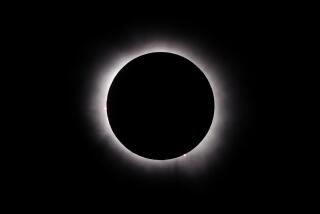Watch X1 solar flare erupt from sun: Flare was unusually strong, fast
An immense solar flare burst from the sun Saturday, and as of Monday there were “several coronal mass ejections in play,” according to NOAA’s Space Weather Prediction Center.
A coronal mass ejection is a huge release --billions of tons -- of solar material and magnetic fields that, if it reaches Earth, can create beautiful auroras as well as cause problems with the power grid.
[Updated 4 p.m. March 30: Heliophysicist Alex Young told the Los Angeles Times this flare was unique in that it was “impulsive” -- providing a strong, quick burst of radiation. Earth is often affected by a coronal mass ejection days after it leaves the sun. In this event, called a magnetic crochet, a large amount of energy was dumped into Earth’s upper atmosphere within eight minutes of leaving the sun.]
The X1-class flare, the strongest class, caused a powerful although brief “radio blackout event” at 10:48 a.m. PDT Saturday, said the agency, which predicted minor geomagnetic storms on Wednesday as well.
Young said the event might graze Earth early Wednesday but would otherwise have little or no impact.
Dean Pesnell at the Solar Dynamics Observatory said the flare provided a “very nice example of coronal dimming.” A dark wave appears to flow north from the site of the solar activity. An event that occurred, he noted, at about 800,000 miles per hour.
[Updated: In the video, Young said, the atmosphere around the flash get dimmer “because material is being moved or blow away. When there is less material, there is less stuff to give off light and so it appears darker. Hence the term coronal dimming.”]
Fellow sun seeker? Follow me at @AmyTheHub
Watch: Deaf woman reacts to hearing for the first time
Scientists create chromosome that mutates on command
Brain hormone makes you lie -- but for the sake of others







